GABAergic inhibition suppresses paroxysmal network activity in the neonatal rodent hippocampus and neocortex
- PMID: 11102490
- PMCID: PMC6773095
- DOI: 10.1523/JNEUROSCI.20-23-08822.2000
GABAergic inhibition suppresses paroxysmal network activity in the neonatal rodent hippocampus and neocortex
Abstract
In the adult cerebral cortex, the neurotransmitter GABA is strongly inhibitory, as it profoundly decreases neuronal excitability and suppresses the network propensity for synchronous activity. When fast, GABA(A) receptor (GABA(A)R)-mediated neurotransmission is blocked in the mature cortex, neuronal firing is synchronized via recurrent excitatory (glutamatergic) synaptic connections, generating population discharges manifested extracellularly as spontaneous paroxysmal field potentials (sPFPs). This epileptogenic effect of GABA(A)R antagonists has rarely been observed in the neonatal cortex, and indeed, GABA in the neonate has been proposed to have an excitatory, rather than inhibitory, action. In contrast, we show here that when fast GABAergic neurotransmission was blocked in slices of neonatal mouse and rat hippocampus and neocortex, sPFPs occurred in nearly half the slices from postnatal day 4 (P4) to P7 neocortex and in most slices from P2 to P7 hippocampus. In Mg(2+)-free solution, GABA(A)R antagonists elicited sPFPs in nearly all slices of P2 and older neocortex and P0 and older hippocampus. Mg(2+)-free solution alone induced spontaneous events in the majority of P2 and older slices from both regions; addition of GABA(A)R antagonists caused a dramatic increase in the mean amplitude, but not frequency, of these events in the hippocampus and in their mean frequency, but not amplitude, in the neocortex. In the hippocampus, GABA(A)R agonists suppressed amplitudes, but not frequency, of sPFPs, whereas glutamate antagonists suppressed frequency but not amplitudes. We conclude that neonatal rodent cerebral cortex possesses glutamatergic circuits capable of generating synchronous network activity and that, as in the adult, tonic GABA(A)R-mediated inhibition prevents this activity from becoming paroxysmal.
Figures
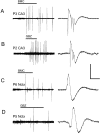
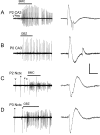
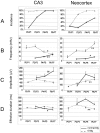
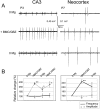
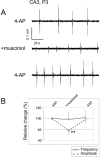
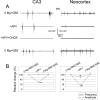

Similar articles
-
Spontaneous recurrent network activity in organotypic rat hippocampal slices.Eur J Neurosci. 2005 Jul;22(1):107-18. doi: 10.1111/j.1460-9568.2005.04198.x. Eur J Neurosci. 2005. PMID: 16029200
-
Spontaneous GABA(A)-dependent synchronous periodic activity in adult rat ventral hippocampal slices.Neurosci Lett. 2002 Feb 8;319(1):17-20. doi: 10.1016/s0304-3940(01)02505-8. Neurosci Lett. 2002. PMID: 11814643
-
Homeostatically regulated spontaneous neuronal discharges protect developing cerebral cortex networks from becoming hyperactive following prolonged blockade of excitatory synaptic receptors.Brain Res. 2006 Aug 23;1106(1):40-45. doi: 10.1016/j.brainres.2006.05.026. Epub 2006 Jul 11. Brain Res. 2006. PMID: 16836981
-
Seizures beget seizures: the quest for GABA as a key player.Crit Rev Neurobiol. 2006;18(1-2):135-44. doi: 10.1615/critrevneurobiol.v18.i1-2.140. Crit Rev Neurobiol. 2006. PMID: 17725516 Review.
-
Physiological effects of sustained blockade of excitatory synaptic transmission on spontaneously active developing neuronal networks--an inquiry into the reciprocal linkage between intrinsic biorhythms and neuroplasticity in early ontogeny.Neurosci Biobehav Rev. 2002 Mar;26(2):127-85. doi: 10.1016/s0149-7634(01)00062-8. Neurosci Biobehav Rev. 2002. PMID: 11856557 Review.
Cited by
-
Brain-derived neurotrophic factor mediates activity-dependent dendritic growth in nonpyramidal neocortical interneurons in developing organotypic cultures.J Neurosci. 2003 Jul 2;23(13):5662-73. doi: 10.1523/JNEUROSCI.23-13-05662.2003. J Neurosci. 2003. PMID: 12843269 Free PMC article.
-
Early development of neuronal activity in the primate hippocampus in utero.J Neurosci. 2001 Dec 15;21(24):9770-81. doi: 10.1523/JNEUROSCI.21-24-09770.2001. J Neurosci. 2001. PMID: 11739585 Free PMC article.
-
Progressive NKCC1-dependent neuronal chloride accumulation during neonatal seizures.J Neurosci. 2010 Sep 1;30(35):11745-61. doi: 10.1523/JNEUROSCI.1769-10.2010. J Neurosci. 2010. PMID: 20810895 Free PMC article.
-
Differences in cortical versus subcortical GABAergic signaling: a candidate mechanism of electroclinical uncoupling of neonatal seizures.Neuron. 2009 Sep 10;63(5):657-72. doi: 10.1016/j.neuron.2009.08.022. Neuron. 2009. PMID: 19755108 Free PMC article.
-
New Evidence for an Important Role of Endogenous GABA in Seizure Generation in the Immature Hippocampus.Epilepsy Curr. 2003 Jul;3(4):142-143. doi: 10.1046/j.1535-7597.2003.03412.x. Epilepsy Curr. 2003. PMID: 15309060 Free PMC article. No abstract available.
References
-
- Agmon A, O'Dowd DK. NMDA receptor-mediated currents are prominent in the thalamocortical synaptic response before maturation of inhibition. J Neurophysiol. 1992;68:345–349. - PubMed
-
- Bains JS, Longacher JM, Staley KJ. Reciprocal interactions between CA3 network activity and strength of recurrent collateral synapses. Nat Neurosci. 1999;2:720–726. - PubMed
-
- Ben-Ari Y, Tseeb V, Raggozzino D, Khazipov R, Gaiarsa JL. gamma-Aminobutyric acid (GABA): a fast excitatory transmitter which may regulate the development of hippocampal neurones in early postnatal life. Prog Brain Res. 1994;102:261–273. - PubMed
Publication types
MeSH terms
Substances
Grants and funding
LinkOut - more resources
Full Text Sources
